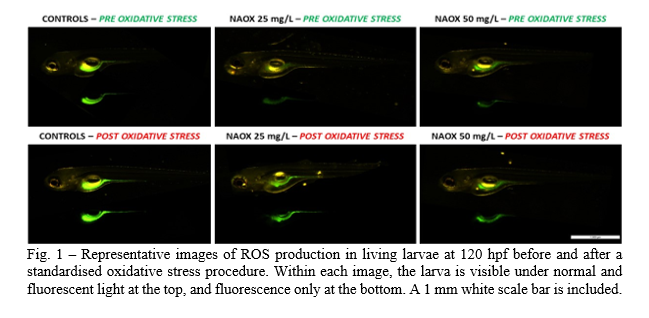NATURAL ANTIOXIDANTS REDUCE OXIDATIVE STRESS AND IMPROVE LARVAL DEVELOPMENT IN ZEBRAFISH Danio rerio
Introduction
Resulting from an imbalance between reactive oxygen species (ROS) production and antioxidant defence, oxidative stress is a critical challenge for fish (Hoseinifar et al., 2020). In aquaculture settings , and particularly in hatcheries, oxidative stress is a major concern during the early stages of fish development due to the high metabolic activity of the larvae and environmental challenges (Menon et al., 2023) . Excessive ROS production triggers lipid peroxidation, protein misfolding, and DNA damage, leading to reduced growth , impaired immune function, and increased susceptibility to disease (Jia, 2025) . To mitigate these adverse effects, natural plant-derived antioxidants are increasingly being used in the aquaculture industry due to their broad-spectrum ROS-scavenging properties, low toxicity, and sustainability compared to synthetic alternatives (Hu et al., 2025) . This study investigated the effects of water exposure to natural antioxidants on the larval development of zebrafish (Danio rerio), a widely recognised model for developmental and toxicological research , and for studying oxidative stress (Chowdhury and Saikia, 2022) . The experimental design focused on three key aspects: survival and hatching rates, morphometric development, and ROS modulation.
Materials and Methods
Wild-type and transgenic casper strains were used . The transparent casper strain, which lacks melanocytes and iridophores , was used to allow accurate in vivo quantification of ROS without interference from skin pigmentation (Rajpurohit et al., 2023). Fish were exposed to six concentrations of a commercially available natural antioxidant formula (0, 2.5, 5, 10, 25 and 50 mg/L) obtained from Marfeed (NAOX , MIAVIT GmbH, Essen, Germany) from 24 to 120 hours post-fertilization (hpf) . Each treatment group consisted of 300 fertilis ed eggs, divided into three replicates. Survival and hatching rates were monitored daily. M orphological characteristics ( such as body length, yolk sac area , and swim bladder inflation) and ROS levels were assessed at 120 hpf in 30 and 10 fish per treatment, respectively, according to Camussi et al. (2024). ROS production was assessed using the fluorescent probe carboxy-H2DCFDA, both under basal conditions and after induction of oxidative stress using the pro-oxidant molecule tert-Butyl hydroperoxide (Naef et al., 2021). Statistical analyses were performed using the Mantel-Cox log-rank test for survival rate data and the ordinary one-way ANOVA multiple comparison test for hatching rate, morphology and ROS data.
Results
The study showe d that antioxidant exposure did not affect survival or hatching rates (p > 0.05) . Treated larvae exhibited significantly increased body length and swim bladder inflation and reduced yolk sac area compared to controls ( p ≤ 0.05) at each tested concentration . Fluorescence-based analysis (Fig. 1) showed a significant reduction in both basal and TBH-induced ROS levels ( p ≤ 0.05) at the 25 and 50 mg/L doses.
Discussion and conclusions
These findings suggest that the natural antioxidants tested are safe up to concentrations of 50 mg/L. Furthermore , exposure to antioxidants enhances larval development by promoting faster development and higher larval metabolism, in agreement with the literature (El Basuini et al., 2022; Shastak and Pelletier, 2023) . The use of the casper strain provided clear evidence of ROS reduction, confirmi ng the utility of these natural compounds in oxidative stress management. Given the conserved nature of antioxidant biology across species (Birnie-Gauvin et al., 2017), zebrafish serve as a rapid and cost-effective model for aquaculture research. This study highlights the potential of natural antioxidants as sustainable tools to improve larval growth and health. Further long-term studies are needed to evaluate the effects of water exposure and dietary supplementation with natural antioxidants on growth performance and disease resistance in commercially farmed species.
References
Hoseinifar, S. H., Yousefi, S., Van Doan, H., et al., 2020. Oxidative Stress and Antioxidant Defense in Fish: The Implications of Probiotic, Prebiotic, and Synbiotics. Reviews in Fisheries Science & Aquaculture, 29:198–217.
Menon, S. V., Kumar, A., Middha, S.K., et al., 2023. Water physicochemical factors and oxidative stress physiology in fish, a review. Frontiers in Environmental Science, 11:1240813.
Jia, R., 2025. Natural Antioxidants and Aquatic Animal Health. Antioxidants, 14: 185.
Hu, X., Ma, W., Zhang, D., Tian, Z., Yang, Y., Huang, Y., Hong, Y., 2025. Application of Natural Antioxidants as Feed Additives in Aquaculture: A Review. Biology, 14:87.
Chowdhury, S., Saikia, S. K., 2022. Use of Zebrafish as a Model Organism to Study Oxidative Stress: A Review. Zebrafish, 19:165–176.
Rajpurohit, S. K., Ouellette, L., Sura, S., et al., 2023. Development of a Transparent Transgenic Zebrafish Cellular Phenotype Tg(6xNF-kB:EGFP); Casper(roy-/-, nacre-/-) to Study NF-kB Activity. Biomedicines, 11: 1985.
Naef, V., Marchese, M., Ogi, A., et al., 2021. Efficient Neuroprotective Rescue of Sacsin-Related Disease Phenotypes in Zebrafish. International Journal of Molecular Sciences, 22:8401.
Camussi, D., Naef, V., Brogi, L., et al., 2024. Delving into the Complexity of Valproate-Induced Autism Spectrum Disorder: The Use of Zebrafish Models. Cells, 13:1349.
El Basuini, M.F., Shahin, S.A., Eldenary, M.E., et al., 2022. Growth variables, feed efficacy, survival rate, and antioxidant capacity of European seabass (Dicentrarchus labrax L.) larvae treated with Coenzyme Q10 or lipoic acid. Aquaculture Reports, 27: 101373.
Shastak, Y., Pelletier, W., 2023. Captivating Colors, Crucial Roles: Astaxanthin’s Antioxidant Impact on Fish Oxidative Stress and Reproductive Performance. Animals, 13:3357.
Birnie-Gauvin, K., Costantini, D., Cooke, S.J., Willmore, W.G., 2017. A comparative and evolutionary approach to oxidative stress in fish: A review. Fish and Fisheries, 18:928–942.
